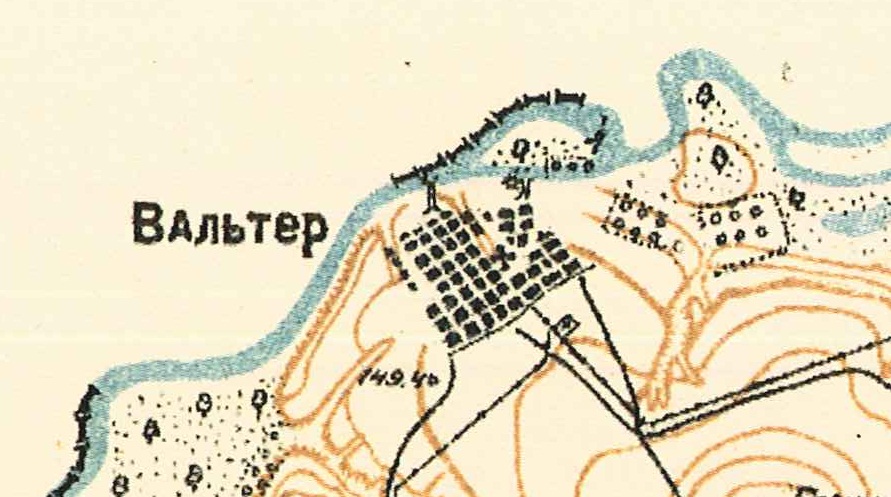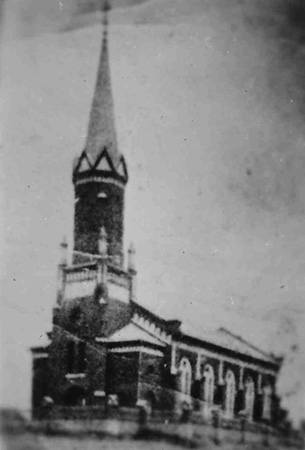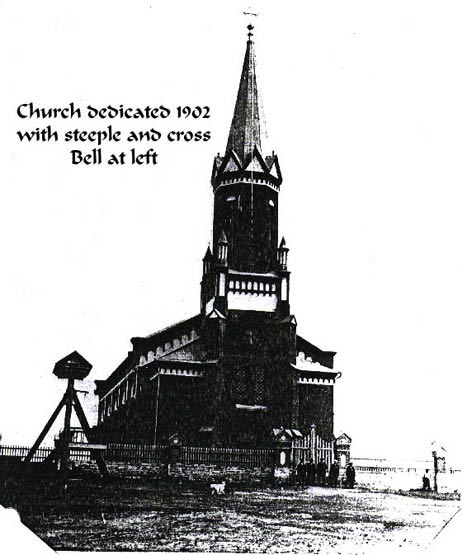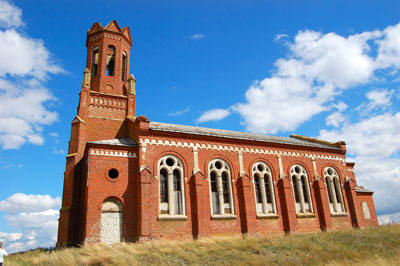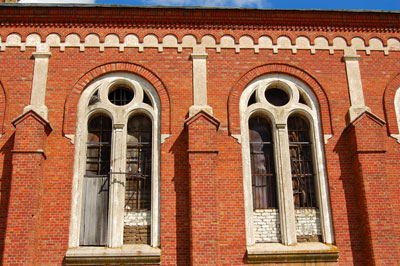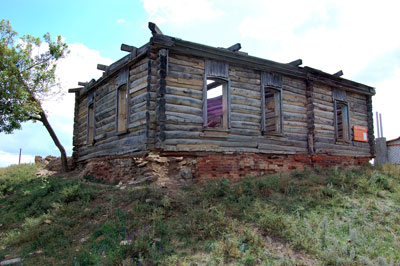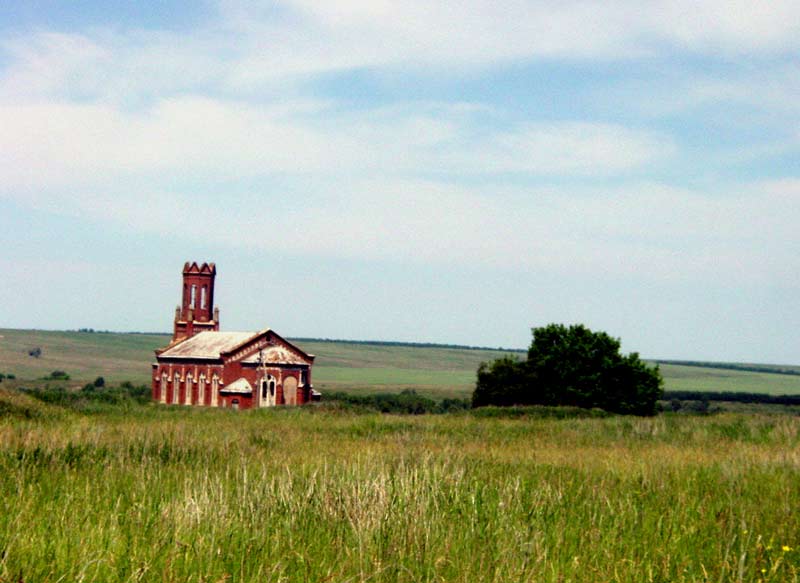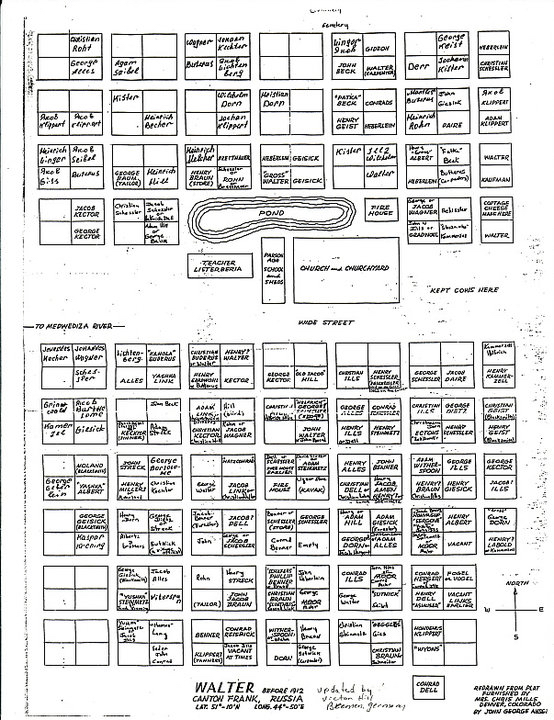In the early years, Walter was part of the Frank parish. A new Lutheran church was dedicated in Walter in 1902.
The church was the largest and most important building in the village. In the Volga region, the Lutheran and Catholic churches of the colonies were usually built in a very traditional architectural style that reflected the colonists' German heritage. All the colonists of Walter were Lutheran and the religious life of the community was tightly tied to the nearby larger Colony of Frank. Walter was in the parish of Frank and the pastors of Frank served Walter and Walter-Khutor and made scheduled visits to conduct religious services. Walter's youth went to Frank for religious instruction and for Confirmation. There was a large parish church in Frank, and later Walter built its village church. The proximity of the two villages of Walter and Frank, as well as others nearby, resulted in inter-village marriages and a blending of the surnames between villages. This was especially true with the villages of Frank, Kolb, and Hussenbach.
The village of Walter had only one church - which was fairly good sized - though certainly not as elaborate as the huge church in Frank which held several thousand people. The present-day Lutheran church in Walter was preceded by a series of earlier, wooden buildings - the last being a wooden prayer house for 1500 people. The new church was a large brick building about 60 feet tall. It was apparently built in the 1880's and mostly finished by 1894, however construction work continued until the church was formally dedicated in 1902. It had a steeple with a big gold cross on top and there were five church bells that were hung inside the tower. The bells were used to communicate with the villagers; ring a call to prayer and services; toll deaths in the community; as a fire alarm, and in the winter, during blizzards, they were rung through the night to help travelers locate the village. There were balconies all around inside so it could hold a lot of people. The church at Walter also had pews inside which was very unusual among the Volga German churches. As was the custom, people did not sit in families. The men would sit on one side and the women on the other. This was the way it had been done in Germany. There was also a big pipe organ and the people used their "Lieders" or songbooks. Walter-Khutor had a "Bethaus" or prayer house. By 1798, there was a school house in which the school teacher, or "Schulmeister", taught reading. writing and religion under the supervision of the pastor.
Walter was founded on 25 August 1767 by the Government as a Lutheran colony. Walter was located on the "Bergseite" or hilly side of the Volga River about 70 miles west of the city of Saratov, about three or four days journey by wagon. Walter was in Saratov Gubneria - an administrative province. Walter belonged to the "Kanton" or Canton of Frank - a county judicial division that included the villages of Frank, Walter, Kolb, Hussenbach, and later the daughter colonies of Frank Khutor, and Walter Khutor. Walter bordered the colonies of Frank, main city of the region, which was about 3 miles away and Kolb which was about 5 miles away.
The Volga colonies were first given a numerical designation before receiving an official Russian name so the name of the first "vorsteher" or mayor was often adopted by the colonists as their village's name. This was true for the colony of Walter. Walter's original Emigration List shows their first "vorsteher" was a 45-year-old farmer, Peter Walter, who came from the village of Kirch Beerfurth in the County of Erbach, Unterhessen (now Hesse-Darmstadt), Germany. At the 1798 census, the vorsteher was Peter Mahr. The official Russian name of Walter was Gretschinnaja-Luka which has been translated several different ways, including "Gretschin's pond or meadow" meaning that it had once belonged to a [Russian] family named Gretschin. Locally, it was nicknamed "Buckwheat Bend" since it was located on the bend of the river. In later years, it was more often known as "Buckwheat Meadows." Currently, the Russian name is Grechinaya Luka.
A census record of the first settlers was made on August 25 and September 10, 1767, shortly after their arrival in the colony. It lists 177 males and 199 females, totaling 376 persons. In the next few years, additional family members came from Germany to join those who had emigrated that first year. Other families immigrated to the new colony during the first few difficult years of settlement, some coming from other colonies on the Volga. Five years after its founding, Walter had a population of 431 in 1772. The revision or census taken on November 10, 1798, lists 413 males, and 349 females, totaling 762 persons in 199 families. There were 208 men able to work and 205 who were not able to work. By 1897, it had risen to 5,900 and in 1912 - the population had reached 6,660 even though many had already left for the counties of the Western Hemisphere. The last reported census figures in 1926 clearly shows the outward migration as the population had now dropped to 2,739. It is not known if these census figures include the daughter colony of Walter Khutor.
|
Year
|
Households
|
Population
|
||
|---|---|---|---|---|
|
Total
|
Male
|
Female
|
||
| 1767 |
107
|
376
|
177
|
199
|
| 1769 |
99
|
382
|
188
|
194
|
| 1773 |
99
|
431
|
224
|
207
|
| 1788 |
|
622
|
|
|
| 1798 |
199
|
762
|
413
|
349
|
| 1816 |
|
1,173
|
|
|
| 1834 |
246
|
1,989
|
|
|
| 1850 |
|
2,899
|
|
|
| 1857 |
253
|
|
|
|
| 1859 |
|
3,264
|
|
|
| 1885 |
|
2,044
|
|
|
| 1891 |
|
|
|
|
| 1894 |
|
|
|
|
| 1897 |
|
2,427*
|
1,219
|
1,208
|
| 1904 |
|
|
|
|
| 1911 |
|
2,291
|
|
|
| 1920 |
286**
|
2,556
|
|
|
| 1922 |
|
2,559
|
|
|
| 1923 |
|
2,754
|
|
|
| 1926 |
389
|
2,494
|
1,219
|
1,275
|
| 1931 |
|
2,138***
|
|
|
*Of whom 2,424 were German.
**Of which 284 households were German.
***Of whom 2,136 were German.
Lutheran
Mai, B. A. (2016). 1834 census of Walter in the district of Saratov, Russia, dated 10 November 1834. Beaverton, Oregon: Dynasty Publishing.
Mai, B. A. (2015). 1857 census of Walter in the district of Saratov, Russia, dated 17 December 1857. Beaverton, Oregon: Dynasty Publishing.
Mills, C., George, John, & American Historical Society of Germans from Russia. (1990). Walter, before 1912, Canton Frank, Russia. Lincoln, Neb.]: [American Historical Society of Germans from Russia].
Roth, J. A., Mills, Mary Troudt, & American Historical Society of Germans from Russia. Walter Village Research Project. (2010). Gretchinnaja Luka = Buckwheat meadow : a history of the German colonies of Walter and Walter Khutor in Russia's Volga River Region. Lincoln, NE]: [American Historical Society of Germans from Russia].
Roth, J. A. (2013). Roth / Hill family of Walter, Russia. United States.
Stump, B. C. (n.d.). Melcher / Becker family from Walter, Russia.
Vashkau, N. Ė, & Dorn, Oxana. (2013). History of German colonies Walter and Rothammel on the river Volga. Lincoln, Neb.: American Historical Society of Germans From Russia.
Diesendorf, V.F. Die Deutschen Russlands : Siedlungen und Siedlungsgebiete : Lexicon. Moscow, 2006.
Orlov, Gregorii. Report of Conditions of Settlements on the Volga to Catherine II , 14 February 1769.
Pallas, P.S. Reise durch verschiedene Provinzen des Russischen Reichs. Theil 3,2, Reise aus Sibirien zurueck an die Wolga im 1773sten Jahr (St. Petersburg: Kaiserl. Academie der Wissenschaften, 1776): 623.
Pleve, Igor. Einwanderung in das Wolgagebiet, 1764-1767 Band 4 (Göttingen: Göttinger Arbeitskreis, 2008): 295-319.
Pleve, Igor R. The German Colonies on the Volga: The Second Half of the Eighteenth Century , translated by Richard Rye (Lincoln, NE: American Historical Society of Germans from Russia, 2001): 318.
Roth, Jene.
"Settlements in the 1897 Census." Journal of the American Historical Society of Germans from Russia (Winter, 1990): 18.
German Lutheran Church in Walter (Tanja Schell - YouTube)
Medveditsa River near Walter (Tanja Schell - YouTube)
